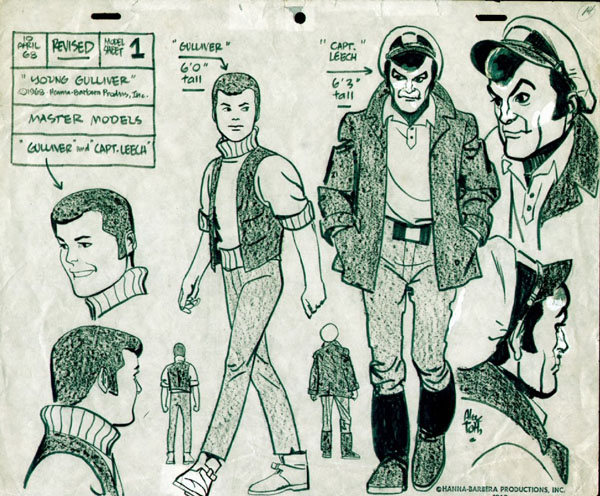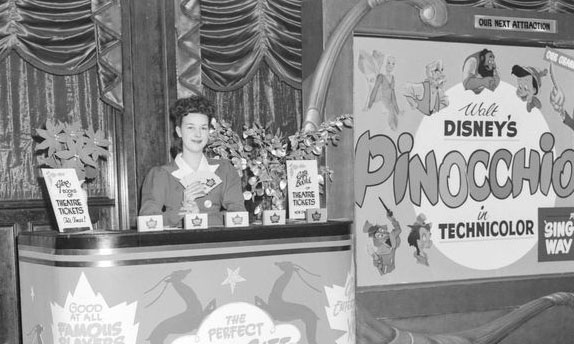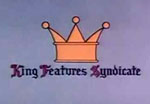Ken Spears on Adventure Animation. In New York Times Magazine November 23rd, 1969, producer Ken Spears said, “I was 21 when I started at (Hanna-Barbera). My partner (Joe Ruby) and I were film editors here. On the side we were doing a bit of writing for the bridges – show openers and closers. Two years ago, Bill Hanna gave me a break. He said, ‘Why not try writing full time?’ We knew this place and our timing was perfect. The timing’s the thing. You can’t dawdle. Anything from comedy to drama here is mainly rapid-fire attack. Otherwise, the kids’ll turn the channel on you.
“We wrote superheroes but we never killed anybody. We never destroyed cities, either. That was wrong for cartoons – too impersonal. We destroyed machines like crazy, though. The network was the dictator. They said, ‘We’re going to buy superheroes this year. If you don’t make them, you’re out of the game’. The public appetite for this kind of thing came from James Bond and it lasted until Robert Kennedy was assassinated. After that, the networks said, ‘The mothers are writing in’. Now there’s no more fighting as such on TV.

“To do adventure without violence is very tough. They not only cracked down on violence, they cracked down on confrontations. So there’s no threat. Take The Adventures of Gulliver (1968). An evil sea captain is after a map. He’s the only heavy on the show. Last year, they said, ‘take away his knife’. He didn’t ever use his knife. It was there as a threat. But they said, ‘No type of weapons whatsoever’. So we had the sea captain kidnap the dog and say to the boy, ‘Give me the map or you’ll never see your dog again’. We leave it to the kids’ imaginations what he’s going to do with the dog.
“Joe and I have adapted. We can write adventure or go funny. We’ve just finished seventeen Penelope Pitstops. Actually, the traps in Penelope are more violent than anything we had in Gulliver – but in comedy you take it with a grain of salt. If it’s adventure, you accept it as real even though it’s a cartoon.”
Eisner’s Introduction to Disney Animation. At a Disney press conference reported in New York’s Newsday April 20, 1984, it was revealed, “(Michael) Eisner was asked about the report that he never saw a Disney animated feature until he was a grown-up. He admitted it was true – that he’d only watched minimal animation shorts on TV ‘like Heckle and Jeckle’. He was in his early 20s when he took his three year old child to a drive-in to see Pinocchio (1940). As he recalled, his child was bored and he and his wife tried to figure out what it was that had made the film a classic.”

 King Kartoons. In April 13, 1988, Variety reported that King Features Enterprises was making a push to get many of its comic strip characters into animated specials on CBS “written not by traditional animation writers but by sitcom writers who are used to writing for a regular audience in the 8 and 8:30 time periods” including one based on Jerry Van Amerongen’s The Neighborhood. “If a property has a foundation to it, it is well thought out, it will last for many years, which is why Mickey Mouse has, which is why Popeye has,” said Ita Golzman, licensing director for King Features. “Too many of the toy-based characters don’t have any foundation to them. The Care Bears are cute little bears but what else are they?”
King Kartoons. In April 13, 1988, Variety reported that King Features Enterprises was making a push to get many of its comic strip characters into animated specials on CBS “written not by traditional animation writers but by sitcom writers who are used to writing for a regular audience in the 8 and 8:30 time periods” including one based on Jerry Van Amerongen’s The Neighborhood. “If a property has a foundation to it, it is well thought out, it will last for many years, which is why Mickey Mouse has, which is why Popeye has,” said Ita Golzman, licensing director for King Features. “Too many of the toy-based characters don’t have any foundation to them. The Care Bears are cute little bears but what else are they?”
The Wisdom of Bluth. In the Washington Post May 1st, 1988, producer and animator Don Bluth said, “Coming here (Ireland) is a dream that has a bigger plan. That dream includes one or two animated films and several live-action pictures each year. But coming to Ireland wasn’t for money. We did it to keep the business alive… to make the next picture. We’ve always taken the money and put it back up on the screen. I’ve never stopped drawing. It’s the thing I do best so I stay with it.
“Drawing’s a catharsis, causing you to go in and sweep out your (mental) rooms. We’re a trio (Gary Goldman and John Pomeroy). Each has something we bring to the table because all three draw. Gary’s best at administration. John’s probably the most excellent animator. My forte lies in story boarding and telling. Generally, we argue everything out. If I get an idea, I go to a table session and we work it out.”
 Clinton the Coyote. In Entertainment Weekly March 26th, 1993, it was reported that President Bill Clinton entertained eighty year old animator and producer Chuck Jones in the Oval Office for roughly an hour in February. Clinton confided, “I often feel like Wile E. Coyote trying to achieve the impossible.”
Clinton the Coyote. In Entertainment Weekly March 26th, 1993, it was reported that President Bill Clinton entertained eighty year old animator and producer Chuck Jones in the Oval Office for roughly an hour in February. Clinton confided, “I often feel like Wile E. Coyote trying to achieve the impossible.”
Andreas Deja and Gaston. In Frontiers magazine January 29th, 1993, animator Andreas Deja stated, “This is really not Walt’s studio anymore. I took my art training very seriously over the years. I had studied the Disney style and analyzed it. When I showed them my portfolio they said it looked like I’d already been working there for twenty years. That was not a prerequisite for the job. You’re encouraged to have a personal style.
“I am happy being a supervising animator. I see no need to become a producer or director. You don’t draw anymore. It’s no fun.
“The Studio was so supportive of Howard Ashman. They didn’t drop him when he became so sick they couldn’t use him. He wanted to know what was happening with Beauty and the Beast (1991) and Jeff Katzenberg and Peter Schneider went to see him in the hospital almost every day with sketches and videos. Jeff wears a red ribbon everywhere.
“I had some challenges with Gaston (in Beauty and the Beast). Jeff said the movement was fine on my initial animation but that Gaston was not handsome enough. He wanted the girls in the audience to sigh. He felt the film’s message was ‘Don’t judge a book by its cover’. So I based him on the men I saw in L.A. gyms. Just go to the gyms, the restaurants, the parking lots. They’re everywhere, looking in the mirror in love with themselves. I did get Jeff to bend a little and agree to let me put a little bend in Gaston’s nose and to uglify him by adding a little (actor Jack) Nicholson to his features.”



 Jim Korkis is an internationally respected animation historian who in recent years has devoted his attention to the many worlds of Disney. He was a columnist for a variety of animation magazines. With his former writing partner, John Cawley, he authored several animation related books including The Encyclopedia of Cartoon Superstars, How to Create Animation, Cartoon Confidential and Get Animated’s Animation Art Buyer’s Guide. He taught animation classes at the Disney Institute in Florida as well as instructing classes on acting and animation history for Disney Feature Animation: Florida.
Jim Korkis is an internationally respected animation historian who in recent years has devoted his attention to the many worlds of Disney. He was a columnist for a variety of animation magazines. With his former writing partner, John Cawley, he authored several animation related books including The Encyclopedia of Cartoon Superstars, How to Create Animation, Cartoon Confidential and Get Animated’s Animation Art Buyer’s Guide. He taught animation classes at the Disney Institute in Florida as well as instructing classes on acting and animation history for Disney Feature Animation: Florida.




















































If you go back and look at the credits of the KFS cartoons from 1962-64, a number of the Snuffy Smith, Beetle Bailey and Krazy Kat cartoons were written by TV sitcom writers, like Michael Ross or Lila Garrett (Ross, who later was involved with “All in the Family” and “Three’s Company” co-wrote the three-part Snuffy episode Paramount released theatrically but which may originally have been targeted as a stand-alone 30-minute show). So what Variety was reporting in 1988 was what the Hearst people running KFS’ animation division were doing a quarter-century earlier.
I remember seeing several of comic comic strips that were converted to prime time special (other than the United Feature Syndicate comic strips Peanuts and Garfield which later became Saturday Morning tv shows) the two most popular were Cathy (United Press Syndicate) with three prime time specials) and King Features Syndicate’s Blondie with Loni Anderson and Frank Welker.with two animated prime time specials.
The HAGAR THE HORRIBLE special created a huge rift between King and H-B. I think it went through eight or nine batches of re-takes.
Damn, I thought something seemed awkward about it when I first saw it.
Blame Glen Kennedy.
As for Eisner, I don’t know why Ron Miller did not sell the company to Yutaka Fujioka and and have the Japanese run the show completely from 1984 onwards, his crew cared about making cartoons and with Toshihiko Masuda & Kenji Hachizaki (AKA the men who replaced Hayao Miyazaki & Isao Takahata respectively after they left Telecom to do Nausicaa at Topcraft) at the helm at Telecom and Japan’s bubble economy being at it’s peek TMS had nothing to lose as said Disney IP profits would of helped out wonders for Little Nemo’s losses.
Who knows about Tiny Toons and ect. (they would of still done it, but the lack of proper Disney would of mean that Warner Bros would of had to take shots at someone else) if this were to ever happen but it would of been better in the long run (IE. by the the time we get to Bob Igor’s Disney) then it is now.
I would disagree with the last statement, as I think John is doing good job running the animation studio (or studios). Granted, I (and John) want to see a traditional animation film to be in production right now, but otherwise I think they’re on the straight and narrow path.
Besides, having a Japanese studio run Disney would mean less (if any) work for the animation employees in the U.S.
@ Mr Famicom
The first season the Glen Kennedy (Kennedy Cartoons) and Fil Cartoons (as well as Freelancers of New Zealand) did some the animation for Tiny Toon Adventures were so-freaking-awful – especially compared to what TMS, Wang Film-Cuckoo Nest & Akom were doing that first season of TTA.
That’s the reason why Warner Bros Animation fired Kennedy Cartoons and Fil Cartoons and replaced them with Startoons of Chicago in season 2 of TTA. As for Glen Kennedy, his Kennedy Cartoons studios and Fil Cartoons were picked up by Hanna Barbera to do the animation for A Pup Named Scooby Doo and that was a total train wreck. We saw the same awful animation that caused them to be ousted from Tiny Toons.
At Nic: The feature unit is fine, it’s the TV unit that is having the issues and TMS had a Los Angeles unit between 1983/4’ish and 1988/9’ish; If TMS were to buy out Disney back in 1984 they would of been TMS’ Los Angeles unit.
At BIGG3469: The reason why I brought up Glen is because he worked on Hagar The Horrible.
Oh, okay. Yeah, I think TMS might do a good job running the television production. Maybe do an animated TV series based on “Perri”, which Disney did a nice live-action feature on. I expect Roy E. Disney being an executive producer on it if he wants(he worked on the film).
Michael Eisner was certainly the perfect choice to helm Disney;s animation department….
At the time he (Eisner) probably was the right choice to run Disney’s animation department. The studio had lost it’s way in the 70’s; by the 80’s it was out of touch with modern audiences. They needed someone from outside; someone who wouldn’t simply imitate the past.
I hate to say that because Pinocchio really is a classic film.
Don luth used to work for Filmation worked on such cartoons as Fantasic Voyage, Journey to the Center of the Earth, Will the Real Jerry Lewis Please Sit Down etc – back in the late 60’s or early 70’s